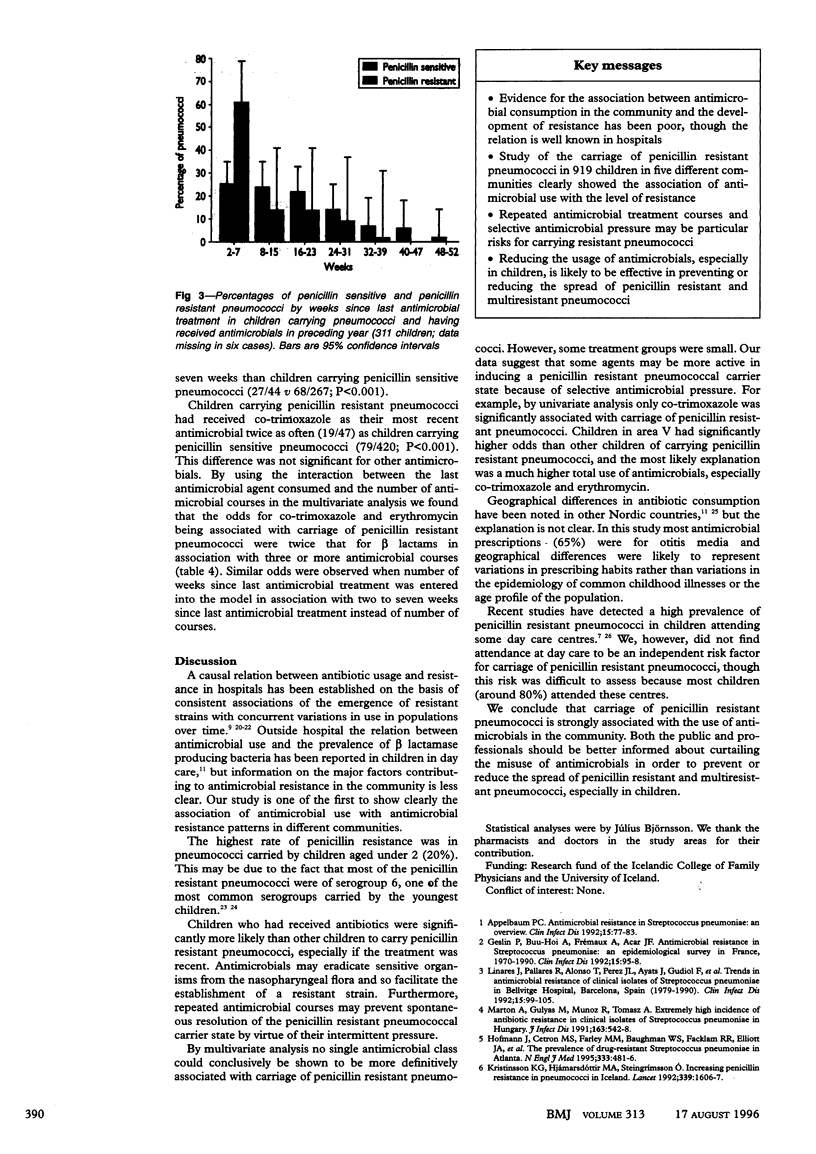Abstract
OBJECTIVE: To study the correlation of antimicrobial consumption with the carriage rate of penicillin resistant and multiresistant pneumococci in children. DESIGN: Cross sectional and analytical prevalence study. SETTING: Five different communities in Iceland. MAIN OUTCOME MEASURE: Prevalence of nasopharyngeal carriage of penicillin resistant pneumococci in children aged under 7 years in relation to antibiotic use as determined by information from parents, patient's records, and total sales of antimicrobials from local pharmacies in four study areas. RESULTS: Total antimicrobial sales for children (6223 prescriptions) among the four areas for which data were available ranged from 9.6 to 23.2 defined daily doses per 1000 children daily (1.1 to 2.6 courses yearly per child). Children under 2 consumed twice as much as 2-6 year olds (20.5 v 10.9 defined daily doses per 1000 children daily). Nasopharyngeal specimens were obtained from 919 children, representing 15-38% of the peer population groups in the different areas. Pneumococci were carried by 484 (52.7%) of the children, 47 (9.7%) of the isolates being resistant to penicillin or multiresistant. By multivariate analysis age (< 2 years), area (highest antimicrobial consumption), and individual use of antimicrobials significantly influenced the odds of carrying penicillin resistant pneumococci. By univariate analysis, recent antimicrobial use (two to seven weeks) and use of co-trimoxazole were also significantly associated with carriage of penicillin resistant pneumococci. CONCLUSIONS: Antimicrobial use, with regard to both individual use and total antimicrobial consumption in the community, is strongly associated with nasopharyngeal carriage of penicillin resistant pneumococci in children. Control measures to reduce the prevalence of penicillin resistant pneumococci should include reducing the use of antimicrobials in community health care.
Full text
PDF




Selected References
These references are in PubMed. This may not be the complete list of references from this article.
- Appelbaum P. C. Antimicrobial resistance in Streptococcus pneumoniae: an overview. Clin Infect Dis. 1992 Jul;15(1):77–83. doi: 10.1093/clinids/15.1.77. [DOI] [PubMed] [Google Scholar]
- Austrian R. Some aspects of the pneumococcal carrier state. J Antimicrob Chemother. 1986 Jul;18 (Suppl A):35–45. doi: 10.1093/jac/18.supplement_a.35. [DOI] [PubMed] [Google Scholar]
- Bro F., Mabeck C. E. Use of antibiotics in general practice in Denmark. Prescribed daily dose, duration of treatment and number of treatments in general practice. Scand J Prim Health Care. 1986 May;4(2):101–104. doi: 10.3109/02813438609014811. [DOI] [PubMed] [Google Scholar]
- Gray B. M., Converse G. M., 3rd, Dillon H. C., Jr Epidemiologic studies of Streptococcus pneumoniae in infants: acquisition, carriage, and infection during the first 24 months of life. J Infect Dis. 1980 Dec;142(6):923–933. doi: 10.1093/infdis/142.6.923. [DOI] [PubMed] [Google Scholar]
- Hofmann J., Cetron M. S., Farley M. M., Baughman W. S., Facklam R. R., Elliott J. A., Deaver K. A., Breiman R. F. The prevalence of drug-resistant Streptococcus pneumoniae in Atlanta. N Engl J Med. 1995 Aug 24;333(8):481–486. doi: 10.1056/NEJM199508243330803. [DOI] [PubMed] [Google Scholar]
- Jacoby G. A., Archer G. L. New mechanisms of bacterial resistance to antimicrobial agents. N Engl J Med. 1991 Feb 28;324(9):601–612. doi: 10.1056/NEJM199102283240906. [DOI] [PubMed] [Google Scholar]
- Kristinsson K. G. Epidemiology of penicillin resistant pneumococci in Iceland. Microb Drug Resist. 1995 Summer;1(2):121–125. doi: 10.1089/mdr.1995.1.121. [DOI] [PubMed] [Google Scholar]
- Kristinsson K. G., Hjálmarsdóttir M. A., Steingrímsson O. Increasing penicillin resistance in pneumococci in Iceland. Lancet. 1992 Jun 27;339(8809):1606–1607. doi: 10.1016/0140-6736(92)91868-9. [DOI] [PubMed] [Google Scholar]
- Kronvall G. A rapid slide-agglutination method for typing pneumococci by means of specific antibody adsorbed to protein A-containing staphylococci. J Med Microbiol. 1973 May;6(2):187–190. doi: 10.1099/00222615-6-2-187. [DOI] [PubMed] [Google Scholar]
- Kuller L. H. Epidemiology of cardiovascular diseases: current perspectives. Am J Epidemiol. 1976 Oct;104(4):425–496. doi: 10.1093/oxfordjournals.aje.a112315. [DOI] [PubMed] [Google Scholar]
- Liñares J., Pallares R., Alonso T., Perez J. L., Ayats J., Gudiol F., Viladrich P. F., Martin R. Trends in antimicrobial resistance of clinical isolates of Streptococcus pneumoniae in Bellvitge Hospital, Barcelona, Spain (1979-1990). Clin Infect Dis. 1992 Jul;15(1):99–105. doi: 10.1093/clinids/15.1.99. [DOI] [PubMed] [Google Scholar]
- Marton A., Gulyas M., Munoz R., Tomasz A. Extremely high incidence of antibiotic resistance in clinical isolates of Streptococcus pneumoniae in Hungary. J Infect Dis. 1991 Mar;163(3):542–548. doi: 10.1093/infdis/163.3.542. [DOI] [PubMed] [Google Scholar]
- McGowan J. E., Jr Antimicrobial resistance in hospital organisms and its relation to antibiotic use. Rev Infect Dis. 1983 Nov-Dec;5(6):1033–1048. doi: 10.1093/clinids/5.6.1033. [DOI] [PubMed] [Google Scholar]
- Mölstad S., Arvidsson E., Eliasson I., Hovelius B., Kamme C., Schalén C. Production of betalactamase by respiratory tract bacteria in children: relationship to antibiotic use. Scand J Prim Health Care. 1992 Mar;10(1):16–20. doi: 10.3109/02813439209014029. [DOI] [PubMed] [Google Scholar]
- Neu H. C. The crisis in antibiotic resistance. Science. 1992 Aug 21;257(5073):1064–1073. doi: 10.1126/science.257.5073.1064. [DOI] [PubMed] [Google Scholar]
- Reichler M. R., Allphin A. A., Breiman R. F., Schreiber J. R., Arnold J. E., McDougal L. K., Facklam R. R., Boxerbaum B., May D., Walton R. O. The spread of multiply resistant Streptococcus pneumoniae at a day care center in Ohio. J Infect Dis. 1992 Dec;166(6):1346–1353. doi: 10.1093/infdis/166.6.1346. [DOI] [PubMed] [Google Scholar]
- Seppälä H., Nissinen A., Järvinen H., Huovinen S., Henriksson T., Herva E., Holm S. E., Jahkola M., Katila M. L., Klaukka T. Resistance to erythromycin in group A streptococci. N Engl J Med. 1992 Jan 30;326(5):292–297. doi: 10.1056/NEJM199201303260503. [DOI] [PubMed] [Google Scholar]
- Soares S., Kristinsson K. G., Musser J. M., Tomasz A. Evidence for the introduction of a multiresistant clone of serotype 6B Streptococcus pneumoniae from Spain to Iceland in the late 1980s. J Infect Dis. 1993 Jul;168(1):158–163. doi: 10.1093/infdis/168.1.158. [DOI] [PubMed] [Google Scholar]
- Swenson J. M., Hill B. C., Thornsberry C. Screening pneumococci for penicillin resistance. J Clin Microbiol. 1986 Nov;24(5):749–752. doi: 10.1128/jcm.24.5.749-752.1986. [DOI] [PMC free article] [PubMed] [Google Scholar]


